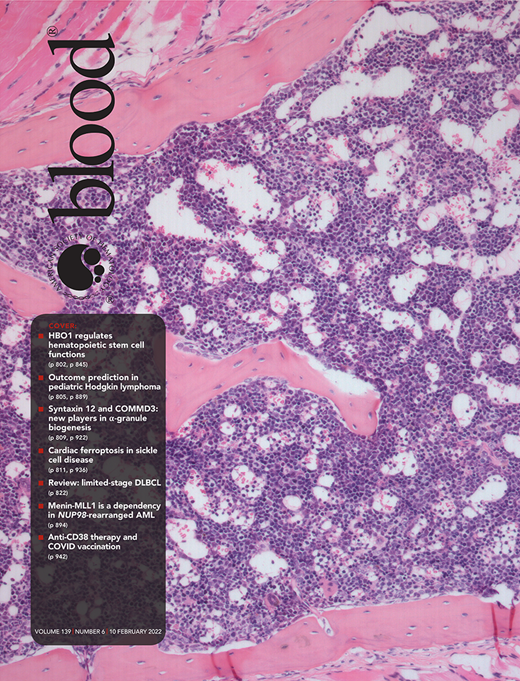In this issue of Blood, Cavo et al1 confirm the prognostic value of minimal residual disease (MRD) negativity in multiple myeloma (MM) by conducting a robust analysis of pooled data of 2510 patients from 4 phase 3 registrational studies. This report is timely, as MRD is being explored as a potential surrogate end point in clinical trials to accelerate regulatory drug approval and guide future treatment strategies for patients with MM.
The achievement of MRD negativity is perhaps the most important prognostic factor in MM, as has been demonstrated in several meta-analyses.2,3 One recent meta-analysis2 of 44 studies in >8000 patients showed that the achievement of MRD negativity improved both progression-free survival (PFS; hazards ratio [HR], 0.33; P < .001) and overall survival (OS; HR, 0.45; P < .001) in patients with MM. The studies included in this meta-analysis were heterogeneous in MRD evaluation methods, MRD sensitivity thresholds, timing, and depth of clinical response at the time of MRD evaluation. Thus, the data presented by Cavo et al are particularly valuable in that they were derived from a sizable cohort of patients with uniform prospective MRD assessment, per the International Myeloma Working Group (IMWG) consensus statement.4 Patients who achieved complete response (≥CR) and were MRD negative had a resounding 80% relative risk reduction in disease progression or death (P < .001). This benefit occurred irrespective of the assigned treatment and disease state (relapsed or newly diagnosed MM), reinforcing the notion that MRD status could serve as an independent surrogate end point for PFS.
In this study, daratumumab-based treatment increased the rate of MRD-negative CR compared with the control and caused prolonged PFS. Among the patients in CR who were MRD negative, daratumumab-based treatment resulted in a 45% risk reduction in progression or death compared with the controls (P = .005). This fact perhaps speaks to the impact of therapy on sustained MRD negativity, which has emerged as a more robust correlate to PFS, as was reported separately in 2 recent publications of the same studies.5,6 Sustained MRD negativity of at least 6 or 12 months incrementally improved PFS, irrespective of the treatment arm for both newly diagnosed MM (NDMM)6 and relapsed/refractory MM (RRMM).5
The longer MRD negativity is sustained, the stronger the positive impact on PFS,5,6 whereas loss of MRD negativity predicts clinical relapse of MM.7 However, the achievement of MRD negativity is not the be-all and end-all for everyone. Attaining MRD negativity is essential for patients with high-risk MM to overcome the poor prognostic impact of adverse cytogenetics.8,9 In contrast, patients with an indolent MM phenotype or active immune reconstitution may not progress with long-term follow-up, despite persisting MRD positivity.7 In this report,1 among patients with poor cytogenetic risk factors, daratumumab-based therapy resulted in a sixfold higher rate of ≥CR with MRD negativity in patients than in controls. Whether this result translates to a PFS shift toward that of the standard-risk group, as occurred in other studies8,9 was not reported.
To date, the biggest challenge for using this end point has been the lack of uniformity and standardization of different MRD assessment techniques, which has posed a problem in data interpretation and comparisons in clinical trials. The international consensus statement for harmonization of performing and reporting MRD in MM clinical trials,10 developed in alignment with the IMWG consensus for response and MRD assessment in MM,4 will unify and improve MRD assessment standards going forward. In many centers, next-generation sequencing (NGS) has superseded the traditional molecular methods of allele-specific oligonucleotide polymerase chain reaction (ASO PCR) or real-time PCR (ASO RQ-PCR). Next-generation flow (NGF) has replaced the conventional 8- or 10-color multiparameter flow cytometry. The IMWG response criteria4 dictates that MRD assessment should be performed in patients who achieve ≥CR according to NGF or NGS, with a sensitivity threshold of at least 10−5.
The data presented by Cavo and colleagues confirm the prognostic and predictive value of MRD status as measured by NGS (clonoSEQ®) with a sensitivity of 10−5 from the largest and relatively uniform set of prospective MRD data collected to date with a long follow-up. The data, together with meta-analyses, including 1 publication in which MRD status fulfilled the Prentice Criteria for PFS surrogacy,3 support MRD status as a surrogate end point for survival in MM clinical trials. A more rapid end point is essential to moving toward effective immunotherapies and powerful triplet and quadruplet regimens in earlier lines of treatment, with the real prospect of operational cure. The time frame to demonstrate statistically significant PFS superiority of new therapies over existing ones will be too long for timely regulatory approval of new drugs.
The exciting challenge in the years ahead will be to unravel the appropriate use of MRD status to guide therapeutic decisions. For example, can we escalate therapy in the presence of MRD positivity or de-escalate therapy upon achieving MRD negativity, particularly in the context of maintenance? What duration of sustained MRD negativity is needed to consider de-escalation/cessation of continuous treatment? Will salvage therapy upon loss of MRD negativity be necessary in our quest for operational cures in MM? These MRD-driven therapeutic strategies are being explored in an increasing number of clinical trials (see table) and are gaining momentum. Undoubtedly, MRD assessment will serve as a gateway to better therapeutic strategies in the quest for an operational cure in MM. The data presented by Cavo et al are a firm step toward this quest, and at the very least, indicate that the use of MRD status as a surrogate end point for PFS in MM is ready for prime time.
Conflict-of-interest disclosure: H.Q. has received research funding from Amgen, GlaxoSmithKline, Celgene, Sanofi, and Karyopharm and has served on advisory boards for Amgen, GlaxoSmithKline, Bristol Myers Squibb, Celgene, Karyopharm, Sanofi, Takeda, Janssen, CSL, and Antengene.

